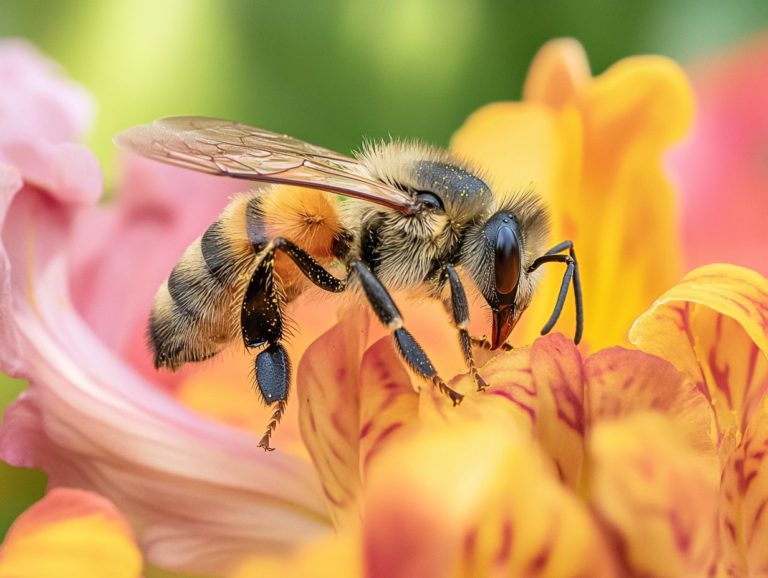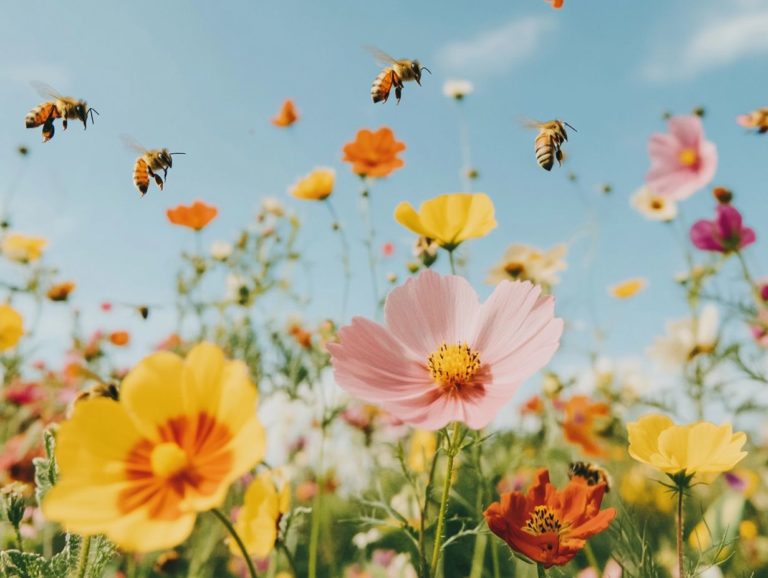The Social Structure of a Beehive
Bees are truly remarkable social insects known for their extraordinary teamwork and intricate social structures. These qualities are vital for the survival and efficiency of their colonies.
This exploration delves into the captivating hierarchy within a beehive. It sheds light on the distinct roles played by the queen bee, worker bees, and drone bees. You ll discover how these remarkable insects communicate through chemical signals and their unique dances. These behaviors reveal the benefits of their highly organized society and the survival of the colony.
Jump into the fascinating world of beehives and discover their secrets!
Contents
- Key Takeaways:
- What Is The Social Structure Of A Beehive?
- What Are The Different Types Of Bees In A Hive?
- How Do Bees Communicate In A Hive?
- Waggle Dance
- What Are The Roles And Responsibilities Of Each Type Of Bee?
- Queen Bee
- Worker Bees
- How Does The Social Structure Benefit The Hive?
- What Happens When a Bee Is Out of Place in the Social Structure?
- Frequently Asked Questions
Key Takeaways:
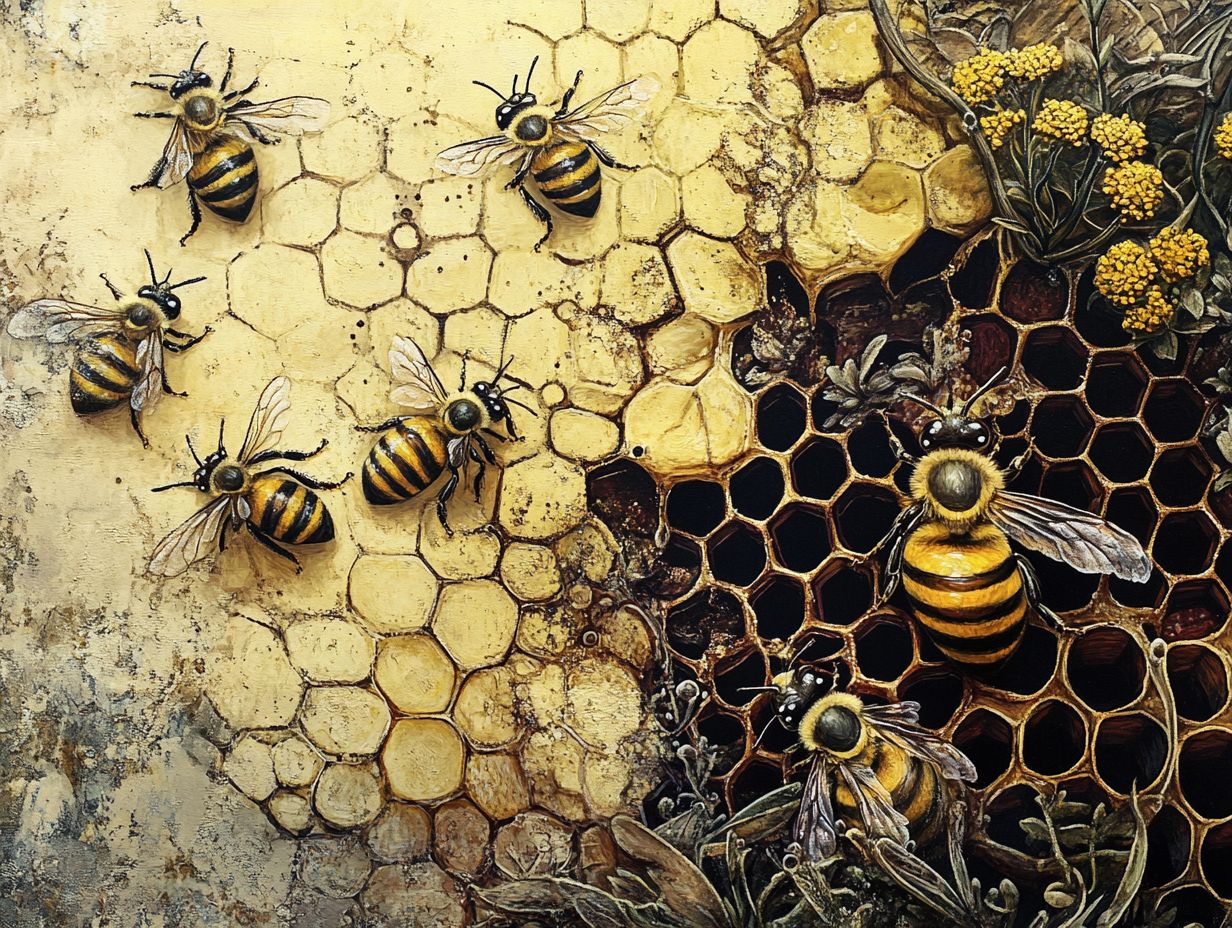
- The social structure of a beehive is hierarchical, with each bee having a specific role and responsibility.
- The three types of bees in a hive are the queen bee, worker bees, and drone bees, each with their unique tasks such as nursing the brood, repairing the hive, and collecting nectar.
- Effective communication through chemical signals and waggle dance allows for efficient division of labor, benefiting the hive as a whole.
What Is The Social Structure Of A Beehive?
The social structure of a beehive presents a captivating and intricate hierarchy. This organization guarantees the survival and efficiency of the colony.
At the heart of this elaborate system lies the queen bee. Her primary responsibility is egg laying and maintaining the colony through her chemical signals.
As an observer, you would notice that worker bees, all female, undertake vital tasks such as hive cleaning and brood nursing. Each action plays a pivotal role in the health and productivity of the hive.
Meanwhile, drone bees have one main job: to mate with the queen bee. This division of roles is essential for sustaining the hive’s vibrancy and ensuring ample honey production.
What Are The Different Types Of Bees In A Hive?
In a beehive, you will find three main types of bees. Each plays a critical role in maintaining the colony’s structure and function: the queen bee, worker bees, and drone bees.
The queen bee, as the sole egg-laying female, is essential for reproduction and ensuring the colony’s longevity. Worker bees, the females of the hive, take on various tasks, from foraging for nectar and pollen to nursing the brood and regulating the hive’s temperature.
Drone bees, the males of the species, exist solely to mate with the queen during her mating flight.
1. Queen Bee
The queen bee is the hive’s heart. She lays eggs and keeps the population strong.
Her role extends beyond mere numbers; she is vital to the overall health and organization of the colony. As the primary female, she releases specific pheromones, which are chemical signals that orchestrate the behaviors of worker bees and foster social harmony within the hive.
These signals influence everything from foraging activities to brood care. This ensures that the colony runs like a well-oiled machine.
A strong queen is crucial for brood development. Her reproductive success is directly linked to the colony s strength, resilience, and ability to thrive and adapt to environmental changes.
2. Worker Bees
Worker bees are the backbone of the beehive. They perform a variety of essential tasks that are crucial for the colony’s survival.
Their responsibilities include nursing the baby bees, searching for food, and maintaining the cleanliness of the hive.
Their lifecycle is a remarkable journey. They begin as nurse bees caring for the developing larvae and evolve into foragers who venture outside to gather essential resources. This transition is key, as each role significantly contributes to keeping the hive vibrant and productive.
Their foraging duties include visiting various sites. These industrious bees also build and maintain the intricate wax structures of the hive.
These structures provide protection and organization for their community. Additionally, they are vigilant defenders, ready to fend off intruders and protect the delicate balance of life within the hive.
Through these diverse roles, worker bees collectively contribute to honey production and bee bread. This not only benefits their colony but also supports the broader ecosystem.
3. Drone Bees
Drone bees hold a remarkable position within the hive. They serve as the male counterparts whose primary focus is mating with the queen bee.
This mating ritual is essential for ensuring the genetic diversity of the colony. Drones emerge from unfertilized eggs and undergo a development period of about 24 days, progressing through the larval and pupal stages.
Unlike their worker bee counterparts, drones lack stingers and are dedicated solely to reproduction. This makes their role during mating flights particularly vital.
These flights occur in specific areas known as drone congregation zones. In these zones, numerous drones assemble, each hopeful for a chance to mate with a queen.
Genetic diversity is crucial for the hive’s health and resilience. It fosters the production of stronger offspring that can adapt to environmental changes.
During the swarming season, it’s vital to maintain a healthy population of drones for the hive’s survival. A robust genetic mix not only bolsters the colony’s survival but also paves the way for future prosperity.
How Do Bees Communicate In A Hive?
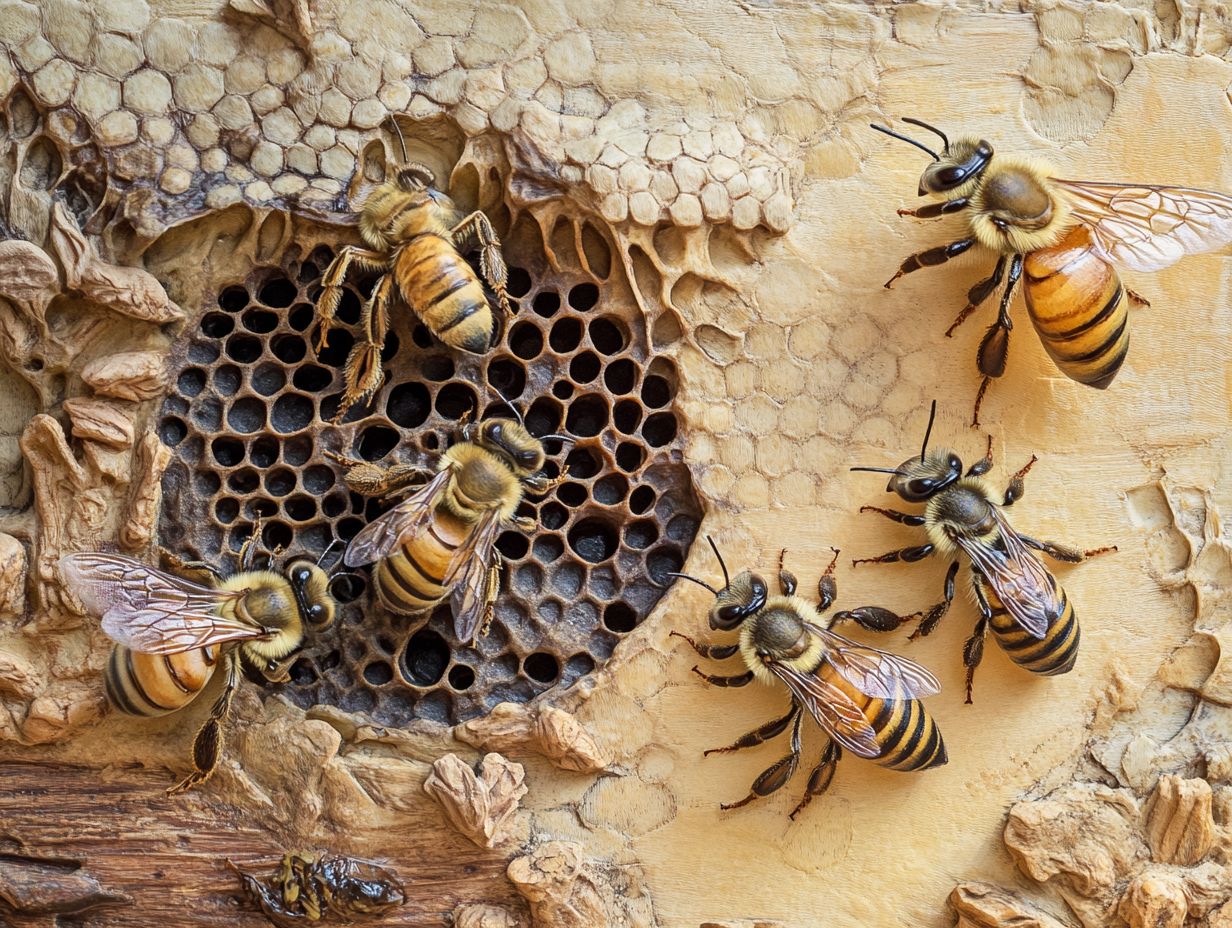
Bees communicate through fascinating chemical signals. They have mastered the art of chemical communication within their hive using sophisticated methods, prominently featuring pheromones and the renowned waggle dance.
Pheromones act as chemical signals, conveying vital information about the queen’s presence, available food sources, and the overall condition of the hive. The waggle dance is an intricate performance by worker bees. They expertly share the locations of bountiful foraging sites with their fellow bees, enhancing the efficiency of nectar collection and pollen gathering.
1. Pheromones
Pheromones are fascinating chemical substances produced by bees. They play a crucial role in their communication and social structure, with the queen substance being essential for maintaining colony cohesion.
Beyond the queen pheromone, bees rely on a variety of other pheromones that significantly influence different facets of hive life. For example, alarm pheromones alert the colony to danger, rallying worker bees for defense. Foraging pheromones guide others to food sources, while brood pheromones stimulate caregiving behaviors among workers, ensuring the healthy development of baby bees within the hive.
These chemical signals do more than just facilitate social interactions. They also support the colony in making collective decisions, such as when to swarm or initiate new activities. This intricate system ensures that the hive operates with remarkable efficiency and cohesion, contributing to overall bee health.
Waggle Dance
The waggle dance is an interesting behavior displayed by worker bees, serving as a vital communication tool that conveys essential information about the distance and direction of food sources. This remarkable dance enhances the efficiency of nectar collection in ways that might surprise you.
As the bees perform their intricate movements waggling followed by precise turns they communicate not just the location of flowers but also the quality of the nectar found at each site. This complex way of sharing food location is crucial for optimizing hive activity, allowing fellow workers to quickly assess and prioritize which resources to exploit.
By sharing this information efficiently, the dance influences interactions within the colony, fostering a coordinated effort to gather food. This teamwork helps the colony survive, ensuring it thrives even in the face of challenging environmental conditions, including environmental control and environmental changes.
What Are The Roles And Responsibilities Of Each Type Of Bee?
Every type of bee in the hive queen bee, worker bees, and drone bees has specialized roles that play a vital part in the hive’s overall function and sustainability.
The queen bee s primary responsibility is to lay eggs, ensuring the colony’s growth and stability. Worker bees, however, are the multitaskers of the hive, managing everything from foraging for nectar to nursing the brood, regulating the hive’s temperature, and maintaining the hive itself.
Meanwhile, drone bees have their own specific duty focused on mating with the queen during the right seasonal windows. The division of labor supercharges hive activity and keeps the colony thriving!
Queen Bee
The queen bee plays a pivotal role in your hive, primarily responsible for egg laying, which is essential for sustaining a robust population of bees necessary for a thriving colony. The queen’s reproductive capabilities are key to the hive’s success.
Her responsibilities transcend mere reproduction; she is the central figure in regulating the hive’s intricate social structure. By releasing various pheromones, she communicates vital information to the worker bees, effectively guiding their actions and responsibilities.
Whether nurturing the brood or preparing for swarming, her chemical signals ensure that all members of the hive work in harmony toward their shared goals. This symbiotic relationship between the queen and her subjects highlights her crucial role not just in reproduction, but also in maintaining the balance and efficiency of the hive.
Worker Bees
Worker bees engage in a remarkable array of tasks that are vital to the hive’s overall functionality. They forage for nectar and pollen, nurse the brood, and maintain the hive’s cleanliness with diligence and care.
These industrious insects start their journey as nursery workers, nurturing developing larvae with a special food that helps larvae grow to ensure their proper growth.
As they mature, they seamlessly transition into roles such as hive defenders, bravely safeguarding their colony against intruders and potential threats. They also demonstrate impressive temperature regulation, fanning their wings to cool the hive on hot days or clustering together to retain warmth when the temperatures drop.
Their adaptability and collaborative spirit are essential to the hive’s success. Each worker assumes different responsibilities based on the hive’s needs, exemplifying a remarkable level of social organization and collective effort that is truly inspiring.
3. Drone Bees
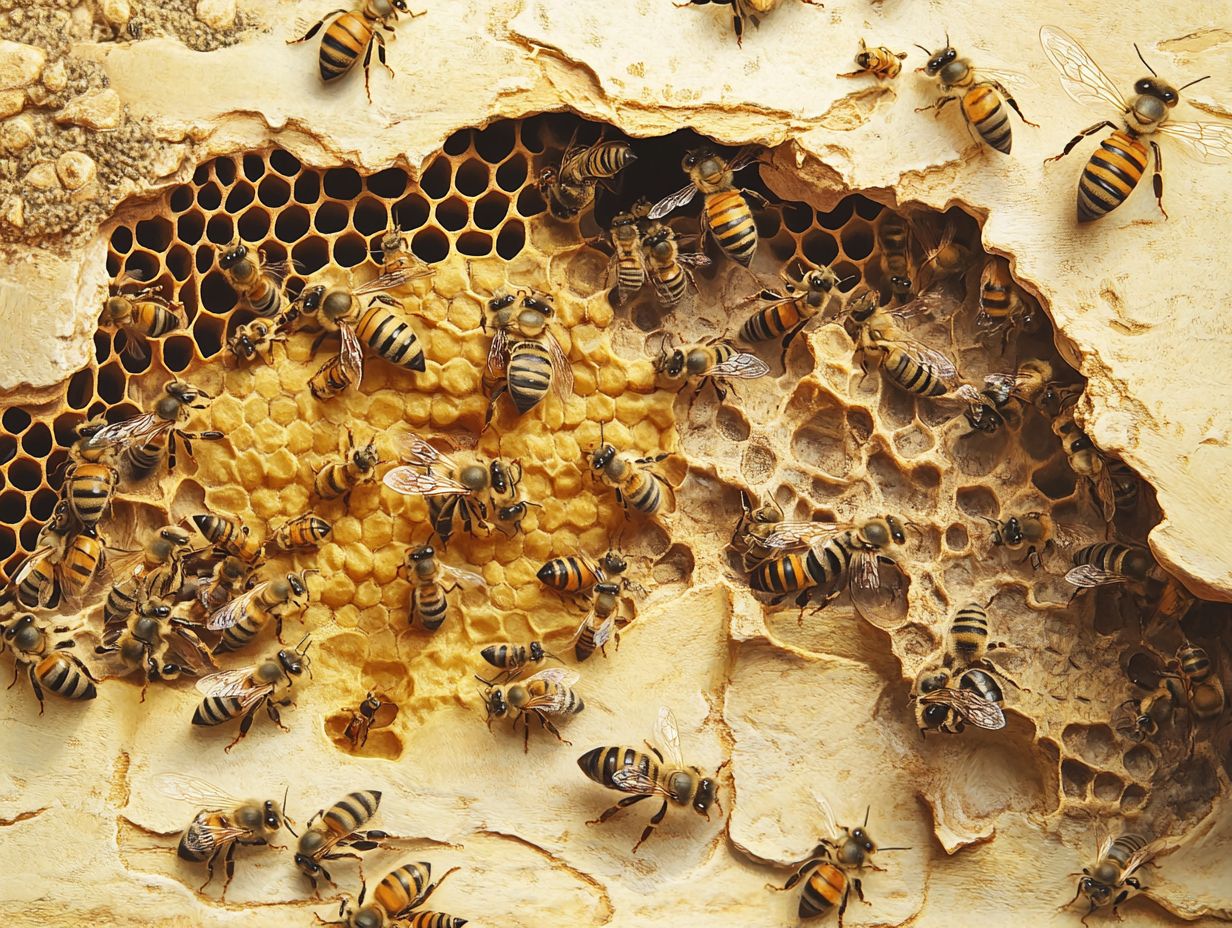
Drone bees play a vital role in the colony’s reproductive cycle. Their primary task is to mate with the queen during her mating flights.
These male bees do not engage in the typical responsibilities of worker bees, such as foraging for food or keeping the hive tidy. Instead, their existence revolves entirely around reproduction.
Their lifecycle begins when the queen lays eggs. These develop into drones, which are noticeably larger and more robust than worker bees.
During mating season, male drones exhibit fascinating behavior. They gather in large groups at drone congregation areas to wait for a virgin queen.
This interaction ensures successful mating and significantly boosts the genetic diversity and resilience of the hive. The greater the genetic variation within the colony, the stronger and healthier it becomes, fostering a more sustainable hive ecosystem.
How Does The Social Structure Benefit The Hive?
The social structure of a beehive presents numerous advantages that enhance the efficiency and success of the colony. This is mainly achieved through a well-organized division of labor among different types of bees.
This meticulous organization facilitates specialized tasks crucial for the colony s growth, such as developing young bees and collecting nectar. It also ensures a robust defense against potential threats.
Worker bees handle cleaning and repairing the hive, which nurtures a healthy environment for brood rearing and honey production.
In essence, this structured social system is vital for the survival and thriving of the colony.
1. Efficient Division Of Labor
The efficient division of labor within a beehive showcases the specialization of roles among worker bees. This ensures that critical tasks are performed effectively and in a timely manner.
This structure allows each worker bee to focus on specific duties, whether it’s foraging for nectar, caring for young bees, cleaning the hive, or guarding against intruders.
Each task is vital to the colony’s health and productivity, creating an environment where bees can truly thrive.
For instance, foragers diligently bring back essential food and nutrients for the queen and larvae. Meanwhile, nurse bees carefully tend to the developing bees, nurturing a robust future generation.
This collaborative effort enhances communication among the bees, ensuring that the hive operates cohesively and adapts seamlessly to external challenges.
2. Reproduction And Growth Of The Hive
The queen bee is the heart of the hive, laying thousands of eggs daily. This reproductive role is essential for the hive’s growth and impacts its overall health.
Her remarkable ability to produce thousands of eggs each day guarantees a steady influx of new workers. This influx is vital for foraging, maintaining the hive, and nurturing the developing brood.
The brood progresses through stages egg, larva, and pupa each requiring specific environmental conditions and attentive care from worker bees.
The successful maturation of these stages not only influences the hive’s immediate dynamics but also its long-term viability. A healthy brood leads to a robust workforce capable of adapting to challenges like food shortages or pest invasions.
Thus, the queen’s prolific nature is intricately connected to the colony’s overall vitality and sustainability.
3. Protection and Defense of the Hive
As a worker bee, protecting the hive is your responsibility. Your role is crucial in keeping the colony safe from threats.
As a diligent protector, you use various strategies to ensure the safety of your home. You can recognize potential dangers and activate specific defense mechanisms when necessary.
Upon detecting an intruder, you alert your fellow hive mates with pheromone signals, igniting a chain reaction of vigilance. Engaging in aggressive behaviors, you stand your ground against attackers, forming a protective perimeter around your colony.
Your teamwork is nothing short of heroic and often involves personal sacrifice for the greater good of the hive.
This instinctual dedication highlights your vital role in maintaining the integrity and survival of your community, ensuring that the colony thrives despite numerous threats.
What Happens When a Bee Is Out of Place in the Social Structure?
When a bee finds itself out of sync with the social structure of the hive, it can create considerable disruptions that ripple through the colony’s organization and harmony.
Worker bees possess an acute awareness of the established hierarchy, relying on pheromonal signals to discern the roles of their companions. If a bee strays from its assigned role, whether due to injury or illness, it may encounter rejection or even aggression from its fellow hive mates, jeopardizing its chances of survival within the colony. Understanding the social dynamics of bee colonies is crucial for any beekeeper.
1. Rejection by Other Bees

When you fail to meet the expectations of your role within the hive, rejection by the other bees can swiftly follow. This can lead to isolation or even aggression from the worker bees.
This behavioral response is intricately woven into the social fabric of the colony. Worker bees have evolved to prioritize efficiency and harmony above all.
If you re perceived as misaligned due to weakness, illness, or inadequate contributions you may find yourself on the receiving end of collective actions ranging from active exclusion to outright hostility.
This rejection can be a game-changer, affecting not just your survival but also having significant ramifications for the dynamics of the entire hive.
A misfit can disrupt foraging patterns, reduce reproductive success, and contribute to the decline in the colony s overall health.
The essential cohesion and cooperative spirit that sustain a thriving hive are put at risk, highlighting the critical importance of each bee’s role and the far-reaching consequences of social dissonance within the community.
2. Removal by Worker Bees
When a bee starts to stray from its expected role, you might observe worker bees taking decisive action. This can include expelling the errant bee from the hive or isolating it in a corner.
This corrective behavior is essential for maintaining the hive’s overall efficiency and health. Worker bees instinctively evaluate the productivity and behavior of their fellow hive members, ensuring that each bee fulfills its specific duties from foraging for nectar to caring for the brood.
If a bee deviates from these responsibilities, whether due to illness, disorientation, or the inevitable effects of aging, the collective decisions of the worker bees to isolate or remove the misaligned individual promote order and minimize risks, such as the spread of disease.
Thus, this behavior is not merely about hive cleaning; it is a vital survival strategy for the colony, allowing it to flourish in a competitive environment while safeguarding the well-being of all its members.
Frequently Asked Questions
The social structure of a beehive is how bees are organized within their colony. It determines the roles and responsibilities of each individual bee and how they work together to ensure the survival and success of the hive.
This organization helps in maintaining the colony’s strength and bee health.
What are the different types of bees in a beehive?
The social structure of a beehive consists of three types of bees: the queen, the workers, and the drones. The queen lays eggs. Workers care for the hive, gather food, and perform repairs. Drones mate with the queen. Worker bees collect nectar and pollen.
How is the queen bee chosen in a beehive?
Workers choose the queen through swarming. They feed select larvae with a special substance called Royal Jelly to help them develop into queens. The first to emerge becomes the queen, while others may become workers or be eliminated. This process is crucial for the colony s survival.
What is the role of worker bees in a beehive?
Worker bees are the most numerous in a beehive. They handle tasks like building comb, cleaning the hive, foraging for food, and defending against predators. Their roles change as they age, moving from caring for larvae to foraging.
Do all bees in a beehive have the same job?
No, not all bees have the same job. Younger bees focus on tasks within the hive, like caring for brood and storing food. Older bees forage outside and defend the hive, ensuring each stage of development is well-managed.
What happens if the queen bee dies in a beehive?
If the queen bee dies, the workers will select a new one. They communicate chemically during this process. Meanwhile, they continue their roles like gathering nectar and producing wax to keep the hive alive.


